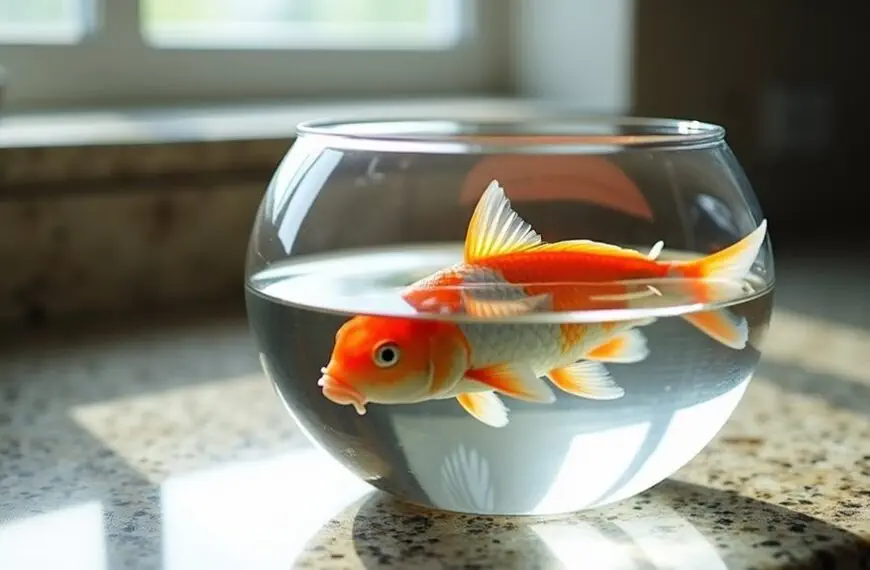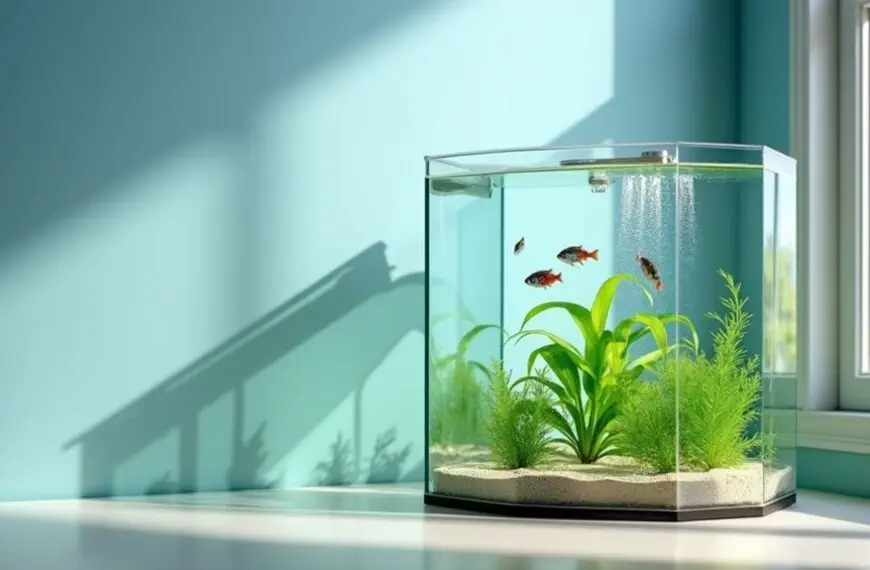White particles floating in your fish tank can stem from several common sources. You're likely seeing substrate breakdown, dead organic matter, or mineral deposits from hard water. These floating bits might also be harmless copepods or planaria that hitched a ride on aquatic plants. While some particles are natural, excessive amounts can signal water quality issues or inadequate filtration. The particles can affect your fish's health by clogging their gills and creating stress, so it's important to identify the source. Regular maintenance, proper feeding, and routine water testing will help you tackle this cloudy situation and keep your aquatic friends happy.
Contents
- 1 Common Causes of White Particles
- 2 Bacterial and Fungal Growth
- 3 Water Quality and Hardness Issues
- 4 Substrate and Equipment Problems
- 5 Impact on Fish Health
- 6 Filter Maintenance and Performance
- 7 Effective Cleanup Methods
- 8 Prevention and Management Strategies
- 9 Long-Term Tank Care Practices
- 10 Frequently Asked Questions
- 10.1 Can White Particles in My Tank Indicate a Parasitic Infection?
- 10.2 How Long Should I Quarantine New Fish to Prevent White Particles?
- 10.3 Do LED Lights Contribute to White Particle Formation in Aquariums?
- 10.4 Will Adding Live Plants Help Reduce White Floating Particles Naturally?
- 10.5 Does Tank Size Affect How Quickly White Particles Accumulate?
- 11 Final Thoughts
Common Causes of White Particles
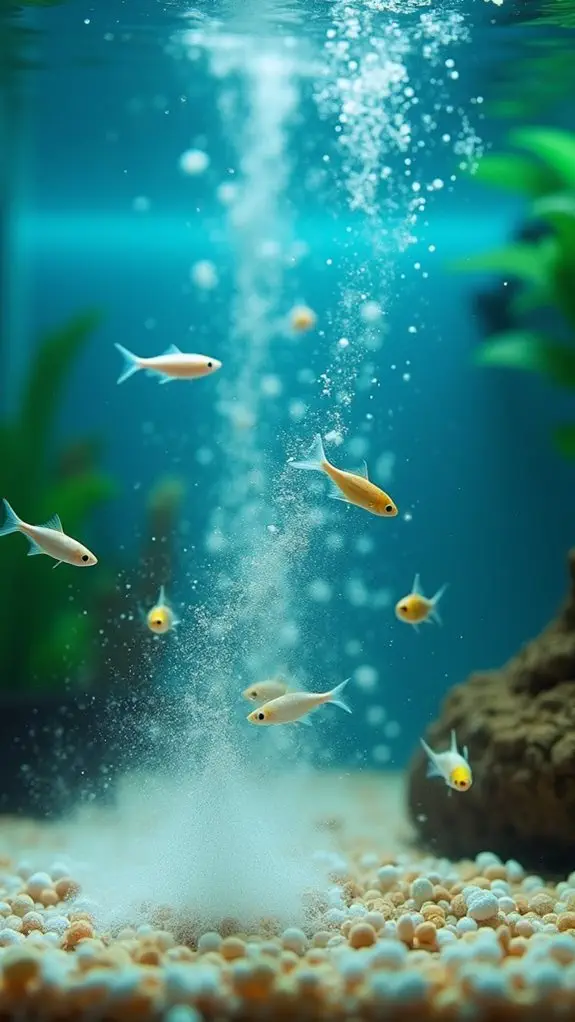
White particles in your aquarium can stem from various sources, both natural and maintenance-related. When you're trying to identify these floating specks, it's helpful to contemplate the different particle sources that might be affecting your tank.
One of the most common culprits is your substrate – those tiny pieces can break down and float up, especially if you've recently set up your tank or disturbed the bottom during cleaning. Dead mosquito larvae can contribute significantly to organic matter buildup in the water. Small organisms like copepods and planaria are often introduced through aquatic plants and can appear as tiny white dots moving around your tank. This effect can be exacerbated by excess waste from overfeeding, which can also contribute to cloudiness in your aquarium.
You'll often find that different substrate types react differently in your aquarium. While some stay firmly in place, others might release fine particles that cloud your water.
Another frequent source is leftover food that hasn't been consumed by your fish. These particles break down over time and can create those pesky white specks you're seeing.
Don't forget about general debris that accumulates in your tank – it's just like dust in your home, except it's underwater!
If you've just completed a major water change or cleaned your tank, you might notice more particles than usual as the disturbed water takes time to settle.
Regular maintenance and proper filtration are your best friends in keeping these floating bits under control.
Bacterial and Fungal Growth
When bacterial and fungal growth invade your aquarium, they often manifest as white, cloudy substances that can alarm even experienced fish keepers. While these unwelcome visitors can seem similar at first glance, they're quite different in nature and require specific approaches for treatment.
You'll notice bacterial infections typically appear as blood-streaked fins or eroded areas around your fish's mouth, while fungal infections show up as those telltale cotton-like growths that seem to float around fins and mouths. If you've ever spotted what looks like your fish wearing a fuzzy white sweater, you're probably dealing with fungi! Dead organic matter in the tank can significantly increase the risk of fungal infections. Poor water parameters can stress your fish and make them more susceptible to infections. Maintaining optimal water quality is crucial to supporting fish health, as it directly minimizes stress and illness.
The good news is that you can prevent both types of infections by maintaining excellent water quality and avoiding common mistakes like overfeeding or overcrowding your tank.
If you're adding new fish or plants to your aquarium, always quarantine them first – think of it as a fish spa retreat where they can prove they're healthy before joining the main tank!
Regular water changes and proper filtration are your best friends in keeping these unwanted guests at bay.
Water Quality and Hardness Issues
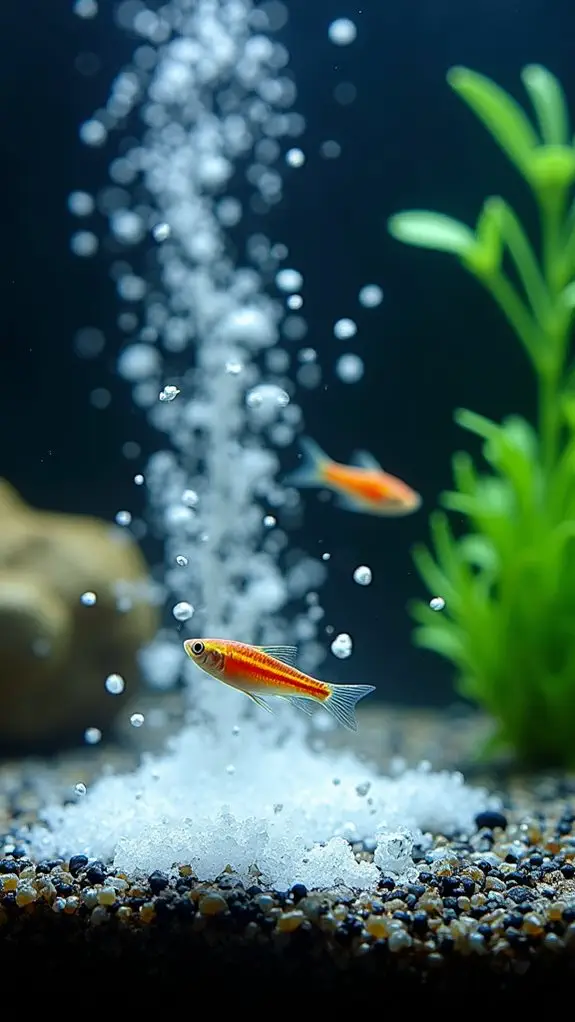
If you're noticing white, crusty deposits on your aquarium glass or equipment, you're likely dealing with calcium scale buildup from hard water conditions.
You'll want to test your water's GH and KH levels right away, as these mineral deposits often indicate your tank's water hardness is too high for ideal fish health. Maintaining balanced water quality parameters is crucial to prevent further complications.
Regular monitoring and testing of your tank's water parameters can help you catch hardness issues before they become severe problems.
The good news is that you can tackle this issue by adjusting your water chemistry through regular water changes using softer water sources, though you'll need to monitor your pH levels closely since water hardness and pH are closely connected. Environmental factors like tap water sources can significantly influence these hardness levels in your aquarium.
Calcium Scale Formation Problems
Calcium scale formation presents three major challenges for aquarium owners: mineral buildup on surfaces, pH fluctuations, and potential harm to aquatic life.
When you're dealing with hard tap water, you'll often notice white deposits forming on your tank's glass, equipment, and decorations. These calcium buildup effects aren't just unsightly – they're telling you something important about your water chemistry. Plants in your aquarium may trigger biogenic decalcification processes when seeking alternative CO2 sources. Regular mechanical filtration through filter socks can help remove floating calcium particles before they settle. Maintaining an ideal pH level can also help reduce the prevalence of calcium deposits.
You'll want to pay close attention to these deposits because they're often a sign that your CO2 levels aren't quite right for your plants. When your aquarium's pH starts swinging up and down due to biogenic decalcification, your fish and plants can really struggle. It's like they're on a chemical roller coaster that's no fun at all!
Fortunately, there are several aquarium maintenance tips you can follow to keep calcium scale in check.
Try using distilled water for your regular water changes, and avoid topping off with mineral-rich water. If you're already seeing deposits, don't worry – a little vinegar or lemon juice can safely remove them from your tank's glass.
Just remember to monitor your water hardness and pH levels regularly to stay ahead of the problem.
Mineral Deposits Testing
Testing for mineral deposits in your aquarium requires a systematic approach to monitor both water quality and hardness levels.
You'll need to conduct regular mineral testing to understand what's affecting your tank's water chemistry. Start by checking your water's pH, as it's often the first indicator of mineral deposit issues. When you notice white residue forming, it's time to investigate further. Consider using RODI filtered water for better control over mineral content. Distilled water replacement can help prevent excessive mineral accumulation during evaporation. Maintaining a stable general hardness (GH) is also crucial in managing mineral deposits effectively.
Your testing kit should include measurements for general hardness (GH) and carbonate hardness (KH), which are essential for deposit identification.
If you're seeing increased mineral buildup, you'll want to test more frequently – perhaps weekly instead of monthly. Remember, those mysterious white patches aren't just unsightly; they're telling you something important about your water conditions.
Keep a log of your test results, as patterns can help you spot potential problems before they become serious.
Ph Balance Effects
Three critical factors – pH levels, water hardness, and mineral content – work together to create your aquarium's delicate chemical balance. When these elements fall out of sync, you'll often notice white deposits appearing in your tank, signaling that something's not quite right with your water chemistry.
pH fluctuations can wreak havoc on your fishy friends' health. If your pH drops too low, it can literally burn your fish's skin and damage their delicate fins – not exactly a spa day for your aquatic pets!
On the flip side, high pH levels can leave them gasping for breath and feeling under the weather. Think of it like trying to swim in a pool that's either too acidic or too alkaline – neither situation is comfortable.
Your water hardness plays an equally important role. Too hard, and you might see those pesky white deposits forming while your fish struggle with excess minerals. Additionally, maintaining a consistent pH range is essential for keeping fish healthy and preventing increased ammonia toxicity.
Too soft, and your fish could have trouble absorbing the nutrients they need to thrive. It's a bit like Goldilocks – you're looking for that "just right" balance to keep your underwater community happy and healthy.
Substrate and Equipment Problems
When dealing with substrate and equipment problems in your fish tank, white substances can emerge from various sources. Your substrate types can release organic compounds, especially if you're using materials like Caribbsea or decorative wood.
You'll often notice white tufts forming when there's a high level of dissolved organics in the water, and certain substrate choices can make this issue worse. If you're considering equipment upgrades, proper filtration and aeration are vital to combat these problems.
Your air pump and filter system play significant roles in preventing white stuff from accumulating. If you notice your air pump making strange noises or losing power, it's likely time to check the rubber diaphragm.
Don't forget to protect your equipment with drip loops and check valves – they're real lifesavers! When your filter starts acting up, the magnetic impeller assembly might be clogged.
Here's a handy tip: cleaning it with white vinegar often does the trick. Remember to maintain regular cleaning schedules for both your substrate and equipment to keep those pesky white substances at bay. Additionally, ensuring optimal water quality can significantly reduce the likelihood of these issues arising in the first place.
Impact on Fish Health
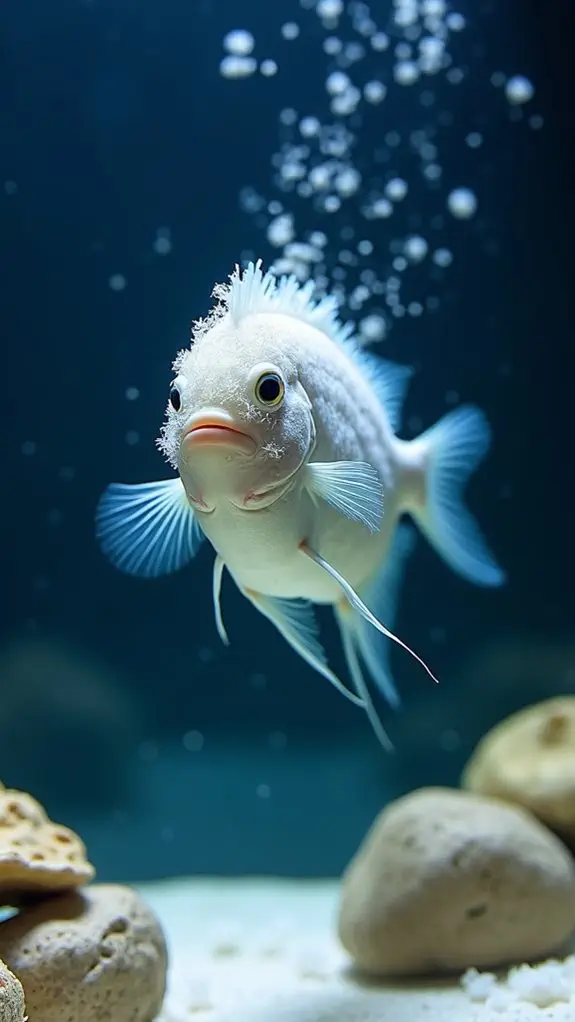
Your fish's respiratory system takes the first hit when white particles cloud your tank, as these tiny troublemakers can clog their gills and make breathing difficult.
When your finned friends struggle to breathe properly, they'll become stressed, and their immune systems won't work as well as they should.
This one-two punch of respiratory issues and weakened immunity means your fish will be more likely to catch diseases, which is why it's so important to address any white clouding in your tank right away. Regular water changes can help maintain water quality and prevent the accumulation of harmful particles.
Respiratory System Effects
The presence of white stuff in a fish tank can lead to severe respiratory distress among your aquatic pets. When particulate matter floats in the water, it can interfere with your fish's normal gill function, making it harder for them to extract the oxygen they need.
Think of it like trying to breathe through a dusty mask – it's not pleasant, and it's definitely not healthy!
Your fish's oxygen uptake can be seriously compromised when these white particles coat their sensitive gill filaments. You'll notice your fish might start breathing more rapidly or even swimming near the surface, desperately trying to get more oxygen.
They're fundamentally going into emergency mode, using their built-in survival mechanisms to cope with the declining water quality.
If you're seeing this behavior, don't wait to act. Poor water quality doesn't just affect their breathing – it can trigger a cascade of health issues. Additionally, routine monitoring of water quality parameters is crucial to ensure a safe environment for your fish. Your fish might start showing signs of stress like rapid gill movements or gasping at the surface.
Stress and Immune Response
Many fish exposed to white particulate matter in their tank experience a double threat to their health: heightened stress and weakened immune responses. When your fish encounter these floating particles, their stress response kicks in, triggering a complex chain of hormonal reactions that can seriously impact their well-being.
Your fish's body reacts to stress in ways that are surprisingly similar to how humans respond. The presence of white stuff in their environment can lead to:
- Release of cortisol, which suppresses their immune system and makes them more vulnerable to diseases
- Reduced ability to maintain proper body chemistry, especially when the particles affect water quality
- Decreased efficiency in fighting off infections, as stress hormones interfere with their immune cells' function
What's particularly concerning is that this immune suppression doesn't just make your fish more susceptible to one problem – it opens the door to multiple health issues.
If you're noticing your fish hiding more often or showing less interest in food, they might be experiencing stress from poor water conditions. The combination of stress and compromised immunity can create a dangerous cycle that's hard to break without addressing the root cause. Additionally, consistent monitoring of water parameters is crucial to ensure a stable and healthy aquarium environment.
Disease Vulnerability Increases
Identifying disease vulnerability in fish becomes essential when white particles compromise tank conditions. When these particles accumulate, they can create a perfect breeding ground for harmful bacteria and parasites that'll make your aquatic friends more susceptible to illness.
You'll notice that poor water quality often leads to stressed fish, making them vulnerable to infections like dropsy and fin rot.
Your aquarium maintenance routine plays an essential role in disease prevention. Regular water changes and proper filtration aren't just chores – they're your first line of defense against potential health issues.
Think of it as giving your fish a clean, stress-free home where they can thrive. If you're noticing white particles, it's time to step up your maintenance game because these particles can trap bacteria and create biofilms on surfaces.
Don't forget that your fish's diet is equally important in fighting off diseases. A varied menu of high-quality foods will boost their immune system, helping them resist infections.
Filter Maintenance and Performance
Proper filter maintenance plays an essential role in preventing white residue buildup in your aquarium. Your filter's performance directly impacts water quality, and sticking to a regular maintenance schedule helps keep those pesky white particles at bay.
You'll want to clean your internal filters every few weeks, while external filters typically need attention every 2-4 weeks, depending on your tank's population.
To maintain peak filter performance, follow these vital steps:
- Monitor your filter's flow rate daily – if it's slowing down, it's time for a cleaning.
- Clean the impeller monthly with a soft cloth to remove debris and algae buildup.
- Replace filter pads every 4-6 weeks, or sooner if you notice reduced water flow.
Don't forget to pay attention to your filter's mechanical media, like sponges and filter wool – they're your first line of defense against floating particles.
If you're noticing white stuff in your tank, check if your filter's mechanical media needs cleaning or replacement.
Effective Cleanup Methods
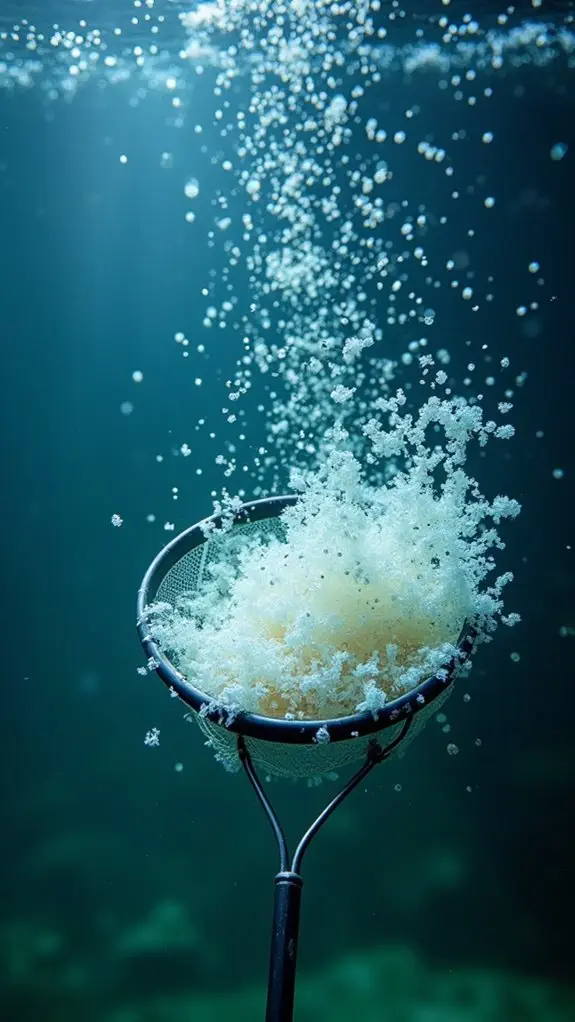
Three essential steps can help you effectively clean white residue from your fish tank.
First, you'll want to perform an initial rinse by carefully hosing down the tank while it's on its side – this prevents stress on the glass while removing loose debris.
After that, grab your sponges and scrapers to tackle any stubborn spots that didn't wash away.
When it comes to cleaning techniques, you've got two reliable options: a water-white vinegar mixture or a properly diluted bleach solution (remember, it's 1 part bleach to 9 parts water).
Don't be tempted to use soap or other types of vinegar, as they can harm your aquatic friends.
As part of your tank maintenance routine, make sure you've unplugged all electrical equipment before getting started.
For the final step, you'll need to thoroughly rinse everything with clean water.
Don't forget to use a dechlorinator when refilling your tank – your fish will thank you!
Keep an eye on your tank after cleaning and regularly inspect all components to catch any potential issues before they become problems.
With these simple steps, you'll have your aquarium looking crystal clear in no time.
Prevention and Management Strategies
Before white residue becomes a persistent issue, implementing preventive strategies can save you time and protect your aquarium's ecosystem. Effective preventative techniques start with smart maintenance routines and careful monitoring of your tank's conditions.
You'll want to establish regular cleaning schedules and keep an eye on water quality parameters to catch problems early.
Here are the top management practices you can't afford to skip:
- Quarantine new materials for at least two weeks, and consider bleach-dipping decorations before adding them to your tank.
- Set up a consistent maintenance schedule that includes weekly water changes and substrate cleaning.
- Monitor your feeding routine closely – it's better to underfeed than overfeed your fish.
Don't forget to add some cleanup crew members to your aquatic family! Algae eaters and other helpful organisms can be your best allies in maintaining a clean tank.
Remember to check your filter regularly and consider upgrading to better filtration if you notice recurring issues. By staying proactive with these prevention strategies, you'll spend less time dealing with white stuff and more time enjoying your underwater paradise.
Long-Term Tank Care Practices
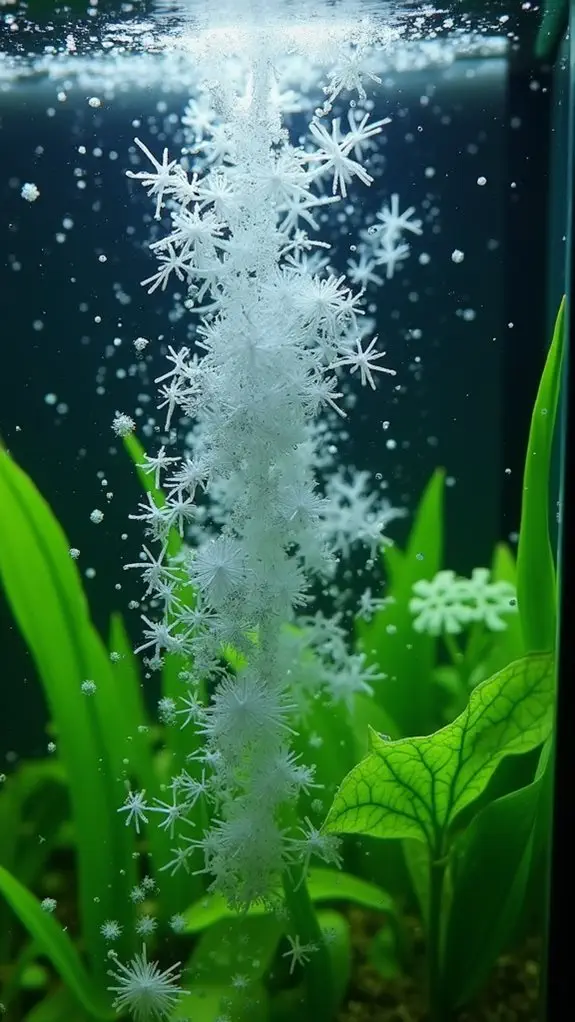
Successful long-term aquarium maintenance requires a systematic approach that extends far beyond daily cleaning tasks. You'll need to focus on creating a balanced tank ecosystem through careful species selection and consistent care routines that'll keep your aquatic friends happy and healthy.
To maintain your tank's long-term health, you'll want to change your filter inserts and media regularly, but don't toss everything at once – those beneficial bacteria are your tank's best friends! Every four weeks, give your filter a thorough rinse, being careful not to disturb the bacterial colonies that keep your water quality in check.
For extra support, consider adding liquid live bacteria every three months or whenever things seem a bit off-balance.
Planning ahead is essential, especially when you're heading out for vacation. Set up an automatic feeder or prepare frozen food portions to keep your fish well-fed without overwhelming the system.
Frequently Asked Questions
Can White Particles in My Tank Indicate a Parasitic Infection?
While white particles can indicate parasitic symptoms, they're not always signs of infection. You'll need to check for specific signs like spots on fish and consider treatment options if parasites are confirmed.
How Long Should I Quarantine New Fish to Prevent White Particles?
You'll need to quarantine new fish for 4-6 weeks to guarantee ideal fish health. This standard quarantine duration helps you monitor for diseases and prevents potential issues before introducing them to your main tank.
Do LED Lights Contribute to White Particle Formation in Aquariums?
LED light effects don't directly cause white particles in your tank. However, if you're not maintaining proper lighting cycles and regular aquarium maintenance, they can contribute to algae growth, which may appear as particles.
Will Adding Live Plants Help Reduce White Floating Particles Naturally?
Yes, you'll find live plants offer excellent natural filtration benefits by absorbing excess nutrients and providing biological filtration. They'll help reduce white particles while creating a healthier aquarium environment for your fish.
Does Tank Size Affect How Quickly White Particles Accumulate?
Yes, your tank's size matters considerably. Larger tank volume slows particle accumulation since there's more space for particle distribution. You'll notice particles build up faster in smaller tanks due to less dilution capacity.
Final Thoughts
You've now got the knowledge to tackle those mysterious white floaties in your tank! By staying on top of regular maintenance, keeping your water parameters in check, and addressing issues quickly, you'll create a clearer, healthier environment for your finned friends. Remember, a clean tank isn't just about aesthetics – it's about giving your fish the best possible home. Keep up with those water changes, and you'll be swimming in success!


